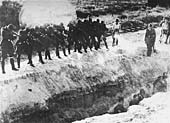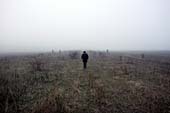- Exhibition presentation
- The Jews in Ukraine
- The start of a genocidal policy
- Radicalization of the genocide
- Father Patrick Desbois and Yahad-In Unum
- The stages of execution
- Panoramic views of the exhibition
The Holocaust by bullets - Shoah Memorial
Exhibition presentation
Between 1941 and 1944, almost one and a half million Ukrainian Jews were assassinated when Nazi Germany invaded the Soviet Union. The immense majority was killed by Einsatzgruppen firing squads (mobile execution units in the East), Waffen SS units, the German police and local collaborators. Only a small minority was shot after having been deported to extermination camps.
The British and Americans became aware of the massacres as early as 1941, and Soviet Commissions registered them between 1944-45. The main perpetrators of the « Holocaust by bullets » were judged during the Einsatzgruppen Nuremberg trials between 1947-48 and, from the late 50"s onwards, in the Federal Republic of Germany.
Despite accounts by the rare survivors and judicial inquiries, this part of Holocaust history, which took place in Eastern Europe, is still virtually unknown. Since 2004, Father Patrick Desbois and the Yahad-In Unum research team have found many Ukrainian witnesses who actually saw the massacres or were requisitioned during the executions of the Jewish population. The witness accounts that Yahad-In Unum have assembled, and systematically compared with written documents, provide information as to the whereabouts of five hundred forgotten common graves. Various pieces of material evidence relating to the genocide (firearms, gun-casing, bullets) have also been gathered together. It has finally become possible to preserve and respect the victims' burial places.
The exhibition at the Shoah Memorial museum, from the 20th of June, 2007 to the 6th of January, 2008, presents their ongoing research. By reconstituting the assassins' procedural methods, it provides one with a better understanding of how the genocide of Eastern European Jews was actually put into practice. It introduces the first results of the Yahad-In Unum team's research, led by Father Patrick Desbois, including part of the ballistic proof found on the sites, and a selection of witness accounts taken over the last six years. The exhibition also covers the archeological expertise of a mass grave, in the village of Busk. Following a request by the Shoah Memorial, Father Patrick Desbois" team began working there in August 2006. Their results confirm the terrible reality of the bullet-ridden genocide perpetrated in Ukraine and across all of the Soviet territory by Nazi troops between 1941 and 1944.
Layout of the exhibition
Father Desbois' researchers have above all recorded on video a very large number of Ukrainian witnesses and survivors of the executions (nearly 500). They have been interviewed throughout Ukraine, about areas which bear little trace of their past history: green meadows, countryside, forests, agricultural land... Ordinary landscapes revealing memories, the traces of which are buried deep beneath the earth.
The challenge was how to present these recently filmed testimonies, alongside past evidence such as the photographic archives taken by the SS during the executions, or the statements by soldiers, and trial testimonies, etc…
And how best to combine the results of Father Desbois' ongoing inquiry with historical documents?
Without meaning to elude the true nature of the documents, the Shoah Memorial has chosen to adopt a non-spectacular form of presentation.
In the first space, which is of a historical nature, a slideshow of the landscapes covered across contemporary Ukraine is presented: countryside and forests where the mass graves have been localized. A first text evokes the history of the Jews of the land which is today called "Ukraine"; their presence there, which dates a long way back, is illustrated by historical postcards and photographs as well as objects which belonged to them; the second historical chapter studies the years between 1939-1945, from the moment the Nazis first put into practice their genocidal policy, until the time they attempted to erase all trace of the extermination of Jews in the East after their defeat at Stalingrad.
A second room presents the eight stages of the extermination process as reconstructed by the Yahad-In Unum team from their extensive work gathering together accounts, proof and documents. Visitors can consult a numerous German and Soviet documents, photographs from archives (including a series of images showing Jews being led out of Lubny towards the execution sites on the outskirts of the town), as well as extracts of the contemporary video recordings taken by Yahad of witnesses in Ukraine. There is also a display of the kind of weapons used by the Nazis in general as well as some actually during the Holocaust executions: assessed and dated by experts, these weapons are the material proof of the genocide.
Lastly, a third room displays the archeological expertise of a mass grave, uncovered by Father Patrick Desbois" team in August, 2006 following a request by the Shoah Memorial. In the middle of the space, the most explicit testimonies of the entire execution procedure in Ukraine are shown in their entirety. They are recounted by survivors, eye witnesses or people who were requisitioned at the time.
The exhibition is not recommended for children given the violent content of the witness accounts.
This exhibition has been conceived by the Shoah Memorial and the Yahad-In Unum Association, with the support of the Foundation for the Memory of the Shoah, in partnership with (the radio) France Culture and ‘L"Histoire"(magazine).
General Commissioner: Sophie Nagiscarde assisted by Marlene Rigler.
Scientific Commissioner: Father Patrick Desbois, President of Yahad-In Unum, director of the National Service of French Bishops for Relations with Judaism, consultant at the Holy See for Relations with Judaism, Edouard Husson, doctor of History, Paris IV-Sorbonne University and Boris Czerny Maître de conférences en langue et civilisation russe, Département d’Etudes Slaves, UFR des Langues Vivantes Etrangères, Université de Caen Basse Normandie.
Assisted by Andrej Umansky, Fanny Chassain and Patrice Bensimon.
Scenography: Natacha Nisic. Contemporary photographs: Guillaume Ribot.

Members of an Einsatzkommando firing at men standing at the bottom of a trench. Circa : 1941-1942. Whereabouts unknown. Photographer unknown.
© USHMM, courtesy of Dokumentatioarchiv of the Oesterreichischen Widerstandes

Simferopol, Ukraine, 2006. Mass grave where 11 000 Jews were shot.
© Guilllaume Ribot